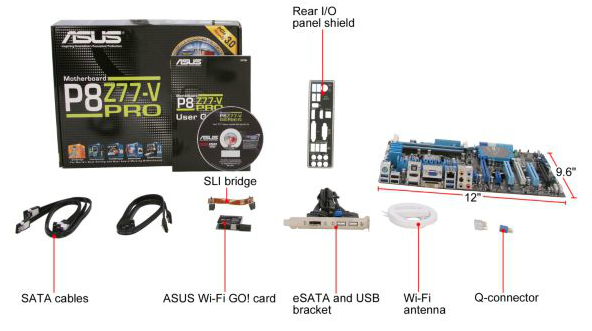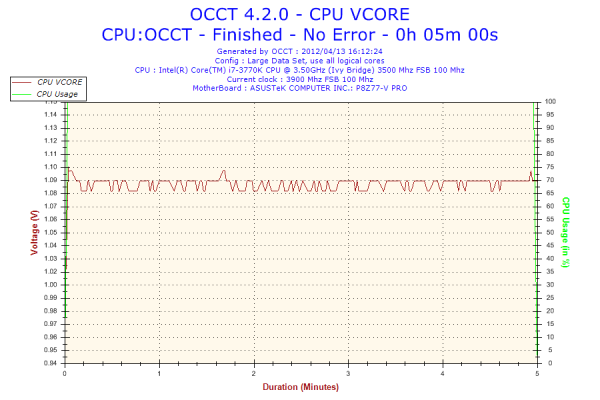Intel Z77 Motherboard Review with Ivy Bridge - ASRock, ASUS, Gigabyte, and MSI
by Ian Cutress on May 7, 2012 7:40 PM EST- Posted in
- Motherboards
- MSI
- Gigabyte
- ASRock
- Asus
- Ivy Bridge
- Z77
ASUS P8Z77-V Pro - In The Box
The ASUS P8Z77-V Pro retails at $225-$235, essentially $100 more than the ASRock Z77 Extreme4, so I would expect a good amount in the box to help sweeten the price point. Thankfully, we get a good amount!
Driver CD
User Manual
IO Panel
4 SATA Cables
SLI Finger
WiFi Go! 802.11 a/b/g/n WiFi card
WiFi magnetic antenna
USB and eSATA back panel
ASUS Q-Connectors

The addition of WiFi on the board obviously adds substantial value – personally, at home, I have my machines connected via WiFi, and ASUS say that at least 25% of their user base is in a similar position, hence the addition to the package.
Voltage Readings
Using OCCT we monitor the voltage change of the motherboard under load. This represents the direct correlation between the Load Line Calibration and how the processor/motherboard deals with voltage requests while under load. This is not to be confused with the quality of power delivery, but more an indication of how aggressive the default LLC settings are on a motherboard.
The ASUS board has regular power delivery, with minimal voltage ripple under load.
Overclocking
Note: Ivy Bridge does not overclock like Sandy Bridge. For a detailed report on the effect of voltage on Ivy Bridge (and thus temperatures and power draw), please read Undervolting and Overclocking on Ivy Bridge.
ASUS overclocking tools have been consistent over the few previous chipsets. In the BIOS, OC Tuner is a simple setting that enables a ‘Fast’ overclock on the system. Similarly, the TPU button on board does a similar action. In the OS, the TurboV Evo part of the software offers ‘Fast’ and ‘Extreme’ auto overclocking modes. For manual overclocking, the TurboV Evo software allows the user to play with an overclock in the OS, which should aid in setting a more permanent overclock in the BIOS.
Auto Overclock: ‘Fast’ mode (either through BIOS or OS) implements an immediate 19% overclock, with 41x on the multiplier and 102 MHz base frequency, ending with 4182 MHz overall. This is coupled with a memory overclock, which in my case it did XMP but backed off one memory strap. What was odd was that the memory was set to a 3T command rate!
‘Extreme’ mode implements a algorithmic testing tool in the OS to probe overclock limits. By slowly upping the multiplier and voltage, the system performs stability tests until the system crashes. The system reboots and then implements BCLK tuning, while still monitoring temperatures. In our test, the initial boot implemented a 20% overclock at 41x103 (4223 MHz), and then performed multiplier testing. At 47x, the system restarted to 46x and started BCLK tuning. At 104.5 MHz, the system restarted again, do a ‘Failed Overclock’ screen on boot. After pressing F1 for Setup, then F10 for Save and Exit, the operating system showed an overall 36% overclock – 46x103.8 (4774 MHz). At load, this gave 1.280 volts at load, giving an immense 94ºC peak temperature during PovRay. I do not think I would be happy with that temperature for a daily system.
Manual Overclock: With the overclock performance of Ivy Bridge processors being highly limited by temperature, having a low voltage is key along with hope that it does not compromise the overclock. In this case, I have started with 1.100 volts on the CPU and adjusting only the CPU multiplier to see what stable overclock we can get, before upping the voltage further. For this, PLL Overvoltage was also enabled.
At 1.100 volts, the highest multiplier that was stable was 45x, giving 4.5 GHz. This gave 68ºC at load with PovRay.
At 1.150 volts, the highest multiplier that was stable was 46x, giving 4.6 GHz. This gave 76ºC at load with PovRay.
At 1.200 volts, the highest multiplier that was stable was 47x, giving 4.7 GHz. This gave 83ºC with PovRay and 86ºC with OCCT. The system did boot at 48x, but gave 94ºC under PovRay as well as memory errors.










117 Comments
View All Comments
bji - Tuesday, May 8, 2012 - link
Don't intelligently designed modern operating systems use as much unused RAM as is available as filesystem cache? I know Linux does, I would expect Windows 7 does as well. In which case, I have to wonder what the value of a RAM disk except to make your persisted data completely volatile and lost on a power outage.Turning the unusable RAM beyond 4 GB into a RAM disk when a 32 bit operating system is in use is the only marginally useful feature that you mentioned, but you have to be stuck with a 32 bit OS for that to be of any value.
Using a RAM disk comes at the cost of vastly increased complexity for managing persisted files (having to copy things from RAM disk to persistent storage before shutting down) and vastly increased risk of loss of data on unexpected power outage. All of the RAM disk useability features in the world won't help with those issues.
Zoomer - Tuesday, May 15, 2012 - link
Temp, cache or scratch files would be good uses of a ramdisk. Other than that, there's really no point.kstan12 - Tuesday, May 8, 2012 - link
i would *love* to read a review of ivy bridge that doesn't include an engineering sample. my i7-3770k seems to want a lot more voltage @ 4.7 than what i see in reviews online. i know one might clock higher than another but it seems these ES samples use less voltage. am i wrong here?and where did you get the updated bios for the asus p8z77-v pro? i can only download 0906. :-)
IanCutress - Tuesday, May 8, 2012 - link
Hi Kstan12,My ES is stepping 9, which is identical to retail. It's all about the luck of the silicon at the end of the day.
Ian
kstan12 - Wednesday, May 9, 2012 - link
oh ok, so you would just compare the stepping, thanks! maybe i'm not so good at overclocking too.love reading your articles...you explain things quite well, good work!
vegemeister - Thursday, May 10, 2012 - link
Unless you bought it retail, they could have easily given you a cherry-picked chip. There is a lot of variation in semiconductor manufacturing, even on the same stepping.Zoomer - Tuesday, May 15, 2012 - link
If that's the results from a cherry picked chip, there would be a very compelling reason to choose SB over IVB for overclockers.JSt0rm01 - Tuesday, May 8, 2012 - link
But I feel like the release schedule has slowed way way way down. We need amd to step back up to the plate. We need more competition. I have been waiting on the new xeon parts for what seems like forever.-------------
Also, after being a member of the anandtech forums for 10 years I was permanently banned by the moderators there because they wanted to censor a website (ffdt.info) that had conversation that was critical of their moderation. I find that the free flow of all information on the internet is critical. For a tech website such as this to limit the flow of information is offensive the core of these beliefs and its all because certain people in positions of illusory power deem that information detrimental to their positions.
bji - Tuesday, May 8, 2012 - link
To your first point, x86 development HAS slowed way down and the trend will continue. With consumer computer usage turning more to cell phones and tablets, the market for faster x86 parts can no longer sustain the billions of dollars of R&D necessary to advance x86 state of the art. Intel is probably in the process of reducing their x86 R&D budgets in anticipation of this.This will not change, even if AMD makes a comeback. I have predicted in the past that the fastest x86 part ever to be produced will be no faster than 50% faster than the current fastest Ivy Bridge. I stand by that prediction.
Sadly, the heady days of rapid advances in x86 tech are over, as anyone who witnessed the early/mid 2000's and can compare them to now will testify to.
JSt0rm01 - Tuesday, May 8, 2012 - link
Its unfortunate for power users. I will probably end up with a 2010 6-core mac pro to replace my aging 2006 macpro (please no anti-apple I use certain software and my industry is almost 100% apple I also have been building my own pcs since 1998) but what comes after that? I've already held this macpro for longer then I've had any computer. I guess what comes next? Will arm processors in 15 years be monsters of computational power?-------------
Also, after being a member of the anandtech forums for 10 years I was permanently banned by the moderators there because they wanted to censor a website (ffdt.info) that had conversation that was critical of their moderation. I find that the free flow of all information on the internet is critical. For a tech website such as this to limit the flow of information is offensive the core of these beliefs and its all because certain people in positions of illusory power deem that information detrimental to their positions.